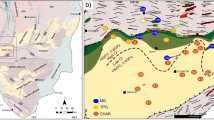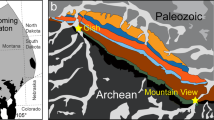Abstract
Halogen composition of replaced apatite formed during a regional metasomatic event (Bamble Sector, SE Norway) reveals information about the composition and evolution of the hydrothermal fluid. Infiltration and pervasive fluid flow of highly saline fluids into gabbroic bodies lead to scapolitization and amphibolitization, where magmatic Cl-rich apatite reacts with the hydrothermal fluid to form OH- and/or F-rich apatite. Apatite from highly altered samples adjacent to the shear zone has highest F (up to 15,000 µg/g) and lowest Br (4–25 µg/g) concentrations, whereas apatite from least altered samples has very low F (30–200 µg/g) and high Br (30–85 µg/g). In addition, individual replaced apatite grains show a zonation in F with high concentrations along rims and cracks and low F in core regions. Iodine concentrations remain rather constant as low values of 0.18–0.70 µg/g. We interpret all observed compositional features of replaced apatite to be the result of a continuous evolution of the fluid during fluid–rock interaction. Due to its high compatibility, F from the infiltrating fluid is incorporated early into recrystallized apatite (close to shear zone and rims of individual apatite grains). In contrast, Br as an incompatible halogen becomes enriched in the fluid and is highest in the most evolved fluid. Using experimental partition data between replaced apatite and fluid, we calculated F concentrations of the evolving fluid to decrease from 60 to <1 µg/g and Br to increase from ~1200 to ~5000 µg/g; I concentrations of the fluid are constant in the order of 370 µg/g. Although Cl is expected to show a similar behavior as Br, replaced apatite has constant Cl concentrations throughout the alteration sequence (~1 wt.%), which is likely the result of a rather constant Cl activity in the fluid. Chlorine stable isotope values of individual apatite grains are heterogeneous and range from −1.2 to +3.7 ‰. High δ 37Cl values are generally correlated with OH-rich zones of replaced apatite, whereas low δ 37Cl values are measured in F-rich zones of replaced apatite and in Cl-apatite of probably magmatic origin. Though apatite δ 37Cl values follow the general bulk trend, the individual δ 37Cl signature seems to reflect the highly localized composition of interfacial fluid at the reaction front. Our observations suggest that apatite can be used as a fluid probe for F, Br, and I to detect a compositional evolution of the fluid, which can be quantified by using experimentally derived partition coefficients. Partitioning of Cl and Cl stable isotopes between highly saline fluids and apatite is complex and likely controlled by more unknown factors than just the Cl concentration.








Similar content being viewed by others
References
Amundson R, Barnes JD, Ewing S, Heimsath A, Chong G (2012) The stable isotope composition of halite and sulfate of hyperarid soils and its relation to aqueous transport. Geochim Cosmochim Acta 99:271–286
Barnes JD, Cisneros M (2012) Mineralogical control on the chlorine isotope composition of altered oceanic crust. Chem Geol 326:51–60. doi:10.1016/j.chemgeo.2012.07.022
Barnes JD, Sharp ZD (2006) A chlorine isotope study of DSDP/ODP serpentinized ultramafic rocks: insights into the serpentinization process. Chem Geol 228:246–265
Bast R et al (2014) Boron isotopes in tourmaline as a tracer of metasomatic processes in the Bamble sector of Southern Norway. Contrib Mineral Petrol 168:1069
Bingen B, Davis WJ, Hamilton MA, Engvik AK, Stein HJ, Skar O, Nordgulen O (2008) Geochronology of high-grade metamorphism in the Sveconorwegian belt, S. Norway: U–Pb, Th–Pb and Re–Os data. Norw J Geol 88:13–42
Boyce JW, Tomlinson SM, McCubbin FM, Greenwood JP, Treiman AH (2014) The lunar apatite paradox. Science 344:400–402. doi:10.1126/science.1250398
Doherty AL, Webster JD, Goldoff BA, Piccoli PM (2014) Partitioning behavior of chlorine and fluorine in felsic melt–fluid(s)–apatite systems at 50 MPa and 850–950 °C. Chem Geol 384:94–109. doi:10.1016/j.chemgeo.2014.06.023
Eggenkamp HGM, Coleman ML (2009) The effect of aqueous diffusion on the fractionation of chlorine and bromine stable isotopes. Geochim Cosmochim Acta 73:3539–3548. doi:10.1016/j.gca.2009.03.036
Engvik AK, Golla-Schindler U, Berndt J, Austrheim H, Putnis A (2009) Intragranular replacement of chlorapatite by hydroxy-fluor-apatite during metasomatism. Lithos 112:236–246
Engvik AK et al (2011) Metasomatism of gabbro–mineral replacement and element mobilization during the Sveconorwegian metamorphic event. J Metamorph Geol 29:399–423
Engvik AK, Ihlen PM, Austrheim H (2014) Characterisation of Na-metasomatism in the Sveconorwegian Bamble Sector of South Norway. Geosci Front 5:659–672. doi:10.1016/j.gsf.2014.03.008
Gleeson SA, Smith MP (2009) The sources and evolution of mineralising fluids in iron oxide–copper–gold systems, Norrbotten, Sweden: constraints from Br/Cl ratios and stable Cl isotopes of fluid inclusion leachates. Geochim Cosmochim Acta 73:5658–5672. doi:10.1016/j.gca.2009.06.005
Godon A, Webster JD, Layne GD, Pineau F (2004) Secondary ion mass spectrometry for the determination of delta Cl-37 part II. Intercalibration of SIMS and IRMS for aluminosilicate glasses. Chem Geol 207:291–303. doi:10.1016/j.chemgeo.2004.04.003
Goldoff B, Webster JD, Harlov DE (2012) Characterization of fluor-chlorapatites by electron probe microanalysis with a focus on time-dependent intensity variation of halogens. Am Mineral 97:1103–1115. doi:10.2138/Am.2012.3812
Harlov DE, Forster HJ (2003) Fluid-induced nucleation of (Y + REE)-phosphate minerals within apatite: nature and experiment. Part II. Fluorapatite. Am Mineral 88:1209–1229
Harlov DE, Forster HJ, Nijland TG (2002) Fluid-induced nucleation of (Y + REE)-phosphate minerals within apatite: nature and experiment. Part I. Chlorapatite. Am Mineral 87:245–261
John T, Scherer EE, Haase K, Schenk V (2004) Trace element fractionation during fluid-induced eclogitization in a subducting slab: trace element and Lu–Hf–Sm–Nd isotope systematics. Earth Planet Sci Lett 227:441–456
John T, Klemd R, Gao J, Garbe-Schonberg CD (2008) Trace-element mobilization in slabs due to non steady-state fluid–rock interaction: constraints from an eclogite-facies transport vein in blueschist (Tianshan, China). Lithos 103:1–24. doi:10.1016/j.lithos.2007.09.005
John T, Layne GD, Haase KM, Barnes JD (2010) Chlorine isotope evidence for crustal recycling into the Earth’s mantle. Earth Planet Sci Lett 298:175–182
John T, Scambelluri M, Frische M, Barnes JD, Bach W (2011) Dehydration of subducting serpentinite: implications for halogen mobility in subduction zones and the deep halogen cycle. Earth Planet Sci Lett 308:65–76
Jones RH, McCubbin FM, Dreeland L, Guan Y, Burger PV, Shearer CK (2014) Phosphate minerals in LL chondrites: a record of the action of fluids during metamorphism on ordinary chondrite parent bodies. Geochim Cosmochim Acta 132:120–140. doi:10.1016/j.gca.2014.01.027
Kusebauch C, John T, Whitehouse MJ, Klemme S, Putnis A (2015a) Distribution of halogens between fluid and apatite during fluid-mediated replacement processes. Geochim Cosmochim Acta. doi:10.1016/j.gca.2015.08.023
Kusebauch C, John T, Barnes J, Klügel A, Austrheim H (2015b) Halogen element and stable chlorine isotope fractionation caused by fluid–rock interaction (Bamble Sector SE Norway). J Petrol 56:299–324
Layne GD, Godon A, Webster JD, Bach W (2004) Secondary ion mass spectrometry for the determination of delta Cl-37 Part I. Ion microprobe analysis of glasses and fluids. Chem Geol 207:277–289. doi:10.1016/j.chemgeo.2004.04.002
Marks MAW et al (2012) The volatile inventory (F, Cl, Br, S, C) of magmatic apatite: an integrated analytical approach. Chem Geol 291:241–255
Mathez EA, Webster JD (2005) Partitioning behavior of chlorine and fluorine in the system apatite-silicate melt-fluid. Geochim Cosmochim Acta 69:1275–1286
McCubbin FM et al (2011) Fluorine and chlorine abundances in lunar apatite: implications for heterogeneous distributions of magmatic volatiles in the lunar interior. Geochim Cosmochim Acta 75:5073–5093. doi:10.1016/j.gca.2011.06.017
Newton RC, Manning CE (2006) Solubilities of corundum, wollastonite and quartz in H2O–NaCl solutions at 800 degrees C and 10 kbar: interaction of simple minerals with brines at high pressure and temperature. Geochim Cosmochim Acta 70:5571–5582. doi:10.1016/j.gca.2006.08.012
Newton RC, Manning CE (2010) Role of saline fluids in deep-crustal and upper-mantle metasomatism: insights from experimental studies. Geofluids 10:58–72. doi:10.1111/j.1468-8123.2009.00275.x
Nijland TG, Touret JLR (2001) Replacement of graphic pegmatite by graphic albite-actinolite-clinopyroxene intergrowths (Mjavatn, southern Norway). Eur J Mineral 13:41–50
Putnis A (2002) Mineral replacement reactions: from macroscopic observations to microscopic mechanisms. Mineral Mag 66:689–708
Rapp JF, Klemme S, Butler IB, Harley SL (2010) Extremely high solubility of rutile in chloride and fluoride-bearing metamorphic fluids: an experimental investigation. Geology 38:323–326. doi:10.1130/G30753.1
Rasmussen KL, Mortensen JK (2013) Magmatic petrogenesis and the evolution of (F:Cl:OH) fluid composition in barren and tungsten skarn-associated plutons using apatite and biotite compositions: Case studies from the northern Canadian Cordillera. Ore Geol Rev 50:118–142. doi:10.1016/j.oregeorev.2012.09.006
Rendon-Angeles JC, Yanagisawa K, Ishizawa N, Oishi S (2000) Effect of metal ions of chlorapatites on the topotaxial replacement by hydroxyapatite under hydrothermal conditions. J Solid State Chem 154:569–578
Schauble EA, Rossman GR, Taylor HP (2003) Theoretical estimates of equilibrium chlorine-isotope fractionations. Geochim Cosmochim Acta 67:3267–3281
Selverstone J, Sharp ZD (2013) Chlorine isotope constraints on fluid–rock interactions during subduction and exhumation of the Zermatt-Saas ophiolite. Geochem Geophys Geosyst 14:4370–4391. doi:10.1002/ggge.20269
Sharp ZD, Barnes JD, Fischer TP, Halick M (2010) An experimental determination of chlorine isotope fractionation in acid systems and applications to volcanic fumaroles. Geochim Cosmochim Ac 74:264–273. doi:10.1016/j.gca.2009.09.032
Sharp ZD, Mercer JA, Jones RH, Brearley AJ, Selverstone J, Bekker A, Stachel T (2013) The chlorine isotope composition of chondrites and Earth. Geochim Cosmochim Acta 107:189–204. doi:10.1016/j.gca.2013.01.003
Sharp Z, Shearer CK, Burger PV, Agee C, McKeegan KD (2014) The unique chlorine Isotope composition of Mars: implications for planetary formation and differentiation. Paper presented at the 45th LPSC conference, Houston
Shearer CK, Sharp Z, McKeegan KD, Burger PV, McCubbin FM (2014) Chlorine isotopic composition of martian meteorites. Implications for the composition of the martian crust and mantle, their interactions, and magmatic processes. Paper presented at the 45th LPSC Conference, Houston
Smith MP, Gleeson SA, Yardley BWD (2013) Hydrothermal fluid evolution and metal transport in the Kiruna District, Sweden: contrasting metal behaviour in aqueous and aqueous-carbonic brines. Geochim Cosmochim Acta 102:89–112
Touret J (1985) Fluid regime in southern Norway: the record of fluid inclusions. In: Tobi AC, Touret J (eds) The deep proterozoic crust in the North Atlantic Provinces. D. Reidel, Dordrecht, pp 517–549
Tropper P, Manning CE, Harlov DE (2013) Experimental determination of CePO4 and YPO4 solubilities in H2O–NaF at 800 °C and 1 GPa: implications for rare earth element transport in high-grade metamorphic fluids. Geofluids 13:372–380. doi:10.1111/Gfl.12031
Tsay A, Zajacz Z, Sanchez-Valle C (2014) Efficient mobilization and fractionation of rare-earth elements by aqueous fluids upon slab dehydration. Earth Planet Sci Lett 398:101–112. doi:10.1016/j.epsl.2014.04.042
Webster JD, Tappen CM, Mandeville CW (2009) Partitioning behavior of chlorine and fluorine in the system apatite-melt-fluid. II: felsic silicate systems at 200 MPa. Geochim Cosmochim Acta 73:559–581
Williams-Jones AE, Heinrich CA (2005) 100th Anniversary special paper: vapor transport of metals and the formation of magmatic-hydrothermal ore deposits. Econ Geol 100:1287–1312. doi:10.2113/100.7.1287
Williams-Jones AE, Migdisov AA, Samson IM (2012) Hydrothermal mobilisation of the rare earth elements—a tale of “Ceria” and “Yttria”. Elements 8:355–360. doi:10.2113/gselements.8.5.355
Yanagisawa K, Rendon-Angeles JC, Ishizawa N, Oishi S (1999) Topotaxial replacement of chlorapatite by hydroxyapatite during hydrothermal ion exchange. Am Mineral 84:1861–1869
Yardley BWD (1985) Apatite composition and the fugacities of HF and HCl in metamorphic fluids. Mineral Mag 49:77–79
Zhu C, Sverjensky DA (1991) Partitioning of F–Cl–OH between minerals and hydrothermal fluids. Geochim Cosmochim Acta 55:1837–1858
Zhu C, Sverjensky DA (1992) F–Cl–OH partitioning between biotite and apatite. Geochim Cosmochim Acta 56:3435–3467
Acknowledgments
The authors thank the workshop at the Department of Mineralogy at Münster University for sample preparation, H. Austrheim for help in the field, furthermore Dr. J. Berndt for his help with the EPMA measurements. Kerstin Lindén in Stockholm helped with sample preparation for SIMS. J. Webster and one anonymous reviewer are thanked for their constructive comments and O. Müntener for editorial handling. The Nordsim facility is operated as a joint Nordic infrastructure—this is Nordsim contribution 420. Funding was provided by the German Research Council (DFG) grant [JO 349/3-1].
Author information
Authors and Affiliations
Corresponding author
Additional information
Communicated by Othmar Müntener.
Electronic supplementary material
Below is the link to the electronic supplementary material.
Rights and permissions
About this article
Cite this article
Kusebauch, C., John, T., Whitehouse, M.J. et al. Apatite as probe for the halogen composition of metamorphic fluids (Bamble Sector, SE Norway). Contrib Mineral Petrol 170, 34 (2015). https://doi.org/10.1007/s00410-015-1188-6
Received:
Accepted:
Published:
DOI: https://doi.org/10.1007/s00410-015-1188-6




